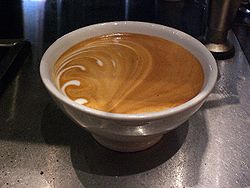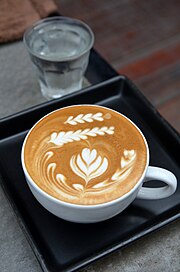How odd! My version of the wikipedia link for latte (
http://en.wikipedia.org/wiki/Latte) seems to have a bit more information than yours.
Latte
From Wikipedia, the free encyclopedia
For the type of pillar found in the Marianas Islands, see
Latte stone.
Latte

Classic Latte
TypeHot
ColorDark brown, beige, black, light brown, white
A
latte (
/ˈlɑːteɪ/ or
/ˈlæteɪ/)
[1][2] is a
coffee ******* made with
espresso and steamed
milk. The term as used in
English is a shortened form of the Italian
caffè latte or
caffellatte (pronounced
[ˌkaffelˈlatte]), which means "milk coffee". The word is also sometimes incorrectly spelled
latté or
lattè in English with different kinds of accents, which can be a
hyperforeignism or a deliberate attempt to help customers realize the word is not pronounced as this combination of letters would normally be interpreted by native speakers.
In northern
Europe and
Scandinavia the term '
café au lait' has traditionally been used for the combination of espresso and milk, but this term is used in the
US for brewed coffee and
scalded milk. In
France, 'caffè latte' is mostly known from American coffee chains; a combination of espresso and steamed milk equivalent to a 'latte' is in French called 'grand crème' and in German 'Milchkaffee' or 'Melange'.
Variants include replacing the coffee with another ******* base such as
masala chai (spiced Indian tea),
mate or
matcha, and other types of milk, such as
soy milk are also used.
Contents
[
hide]
Origin[edit]

 Latte Art
Latte Art
Coffee and milk have been part of European cuisine since the 17th century (there is no mention of milk in coffee pre 1600 in Turkey or in the Arab world). 'Caffèlatte', 'Milchkaffee', 'Café au lait' and 'Café con leche' are domestic terms of traditional ways of drinking coffee, usually as part of breakfast in the home. Public Cafés in Europe and the US it seems have no mention of the terms until the 20th century, although 'Kapuziner' is mentioned in Austrian coffee houses in Vienna and Trieste in the 2nd half of the 1700s as 'coffee with cream, spices and sugar' (being the origin of the Italian 'cappuccino').
According to the
Oxford English Dictionary, the term caffè latte was first used in English in 1867 as caffè latte by
William Dean Howells in his essay "Italian Journeys".
[3] Kenneth David maintains that "...breakfast drinks of this kind have existed in Europe for generations, but the (commercial) caffè version of this ******* is an American invention".
[4]
The French term 'Café au lait' was used in cafés in several countries in western continental Europe from 1900 onwards, while the French themselves started using the term 'café crème' for coffee with milk or cream.
The Austrian-Hungarian empire (eastern Europe) had its own terminology for the coffees being served in coffee houses, while in German homes it was still called 'milchkaffee'. The Italians used the term 'caffèlatte' domestically, but it is not known from cafès like 'Florian' in Venice or any other coffee houses or places where coffee was served publicly. Even when the Italian espresso bar culture bloomed in the years after WW2 both in Italy, and in cities like Vienna and London, 'espresso' and 'cappuccino' are the terms, 'latte' is missing on coffee menus.
In
Italian latte (pronounced
[ˈlatte]) means
milk—so ordering a "latte" in Italy will get the customer a glass of milk.
[5][6]
In English-speaking countries 'latte' is shorthand for "
caffelatte" or "
caffellatte" ("
caffè e latte"), which is similar to the
French café au lait, the
Spanish café con leche, the
Catalancafè amb llet or the
Portuguese galão.
The
Caffe Mediterraneum in
Berkeley, California claims Lino Meiorin, one of its early owners, "invented" and "made the latte a standard *******" in the 1950s.
[7] The latte was popularized in
Seattle, Washington in the early 1980s
[8] and spread more widely in the early 1990s.
[9]
In northern Europe and Scandinavia, a similar 'trend' started in the early 1980s as 'Café au lait' became popular again, prepared with espresso and steamed milk. 'Caffè Latte' started replacing this term around 1996-97, but both names exist side by side, more often more similar than different in preparation.
Spelling variations[edit]
Coffee menus worldwide use a number of spelling variations for words to indicate coffee and milk, often using incorrect accents or a combination of French and Italian terms.
Italianis
caffellatte (the standard form;
caffelatte is a Northern Italian variation), contracted from
caffè-latte, (with a
grave accent over the e), while
French is
café au lait (with an
acute accent);
Spanish is
café con leche and
Portuguese is
café com leite. Variants such as
caffé latté, café latte, and
caffé lattè are commonly seen in English.
Current use[edit]
In Italy, caffelatte is almost always prepared at home, for breakfast only. The coffee is brewed with a stovetop
Moka pot and poured into a cup containing heated milk. (Unlike the international latte *******, the milk in the Italian original is not foamed.)
Outside Italy, a caffè latte is typically prepared in a 240 mL (8 oz) glass or cup with one standard shot of
espresso (either single, 30 mL, or double, 60 mL) and filled with steamed milk, with a layer of foamed milk approximately 12 mm (½ inch) thick on the top. A caffè latte may also be served consisting of strong or bold coffee (sometimes espresso) mixed with
scalded milk in approximately a 1:1 ratio.
[10] The ******* is similar to a
cappuccino, the difference being that a cappuccino consists of espresso and steamed milk with a 20 mm (¾ inch) layer of thick milk foam. An Australian variant similar to the latte is the
flat white, which is served in a smaller ceramic cup with the micro-foamed milk. In the United States this beverage is sometimes referred to as a wet cappuccino.
Caffè latte vs. latte macchiato[edit]
***************************************************************************************
key words are in the first sentence: a latte is a ******* made with espresso and steamed milk.
I've worked in restaurants my entire life...I grew up with my family owning a restaurant with an espresso machine. I've made thousands upon thousands of lattes....which every barista knows is simply espresso and steamed milk.
***************************************************************************************
it's a matter of dominant genes




